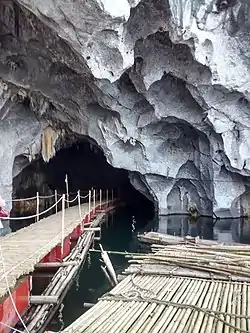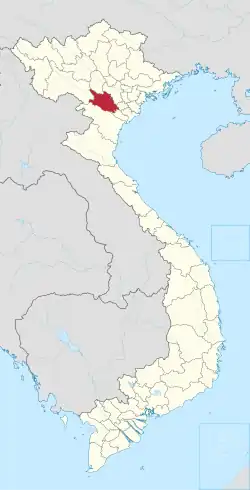Hòa Bình province
Hòa Bình or Hoà Bình (Vietnamese: [hwaː˨˩ ʔɓïŋ˨˩] ⓘ) is a mountainous province of Vietnam, located in the nation's Northwest region. It borders Phú Thọ province and Sơn La province to the northwest, Hanoi to the northeast, Hà Nam province to the east, Ninh Bình province to the southeast and Thanh Hóa province to the south. The province covers an area of 4590.57 square kilometres and as of 2019 it had a population of 854,131 people.[2] In 2020, the GDP per capita of the province was estimated to be $2625 (equivalent to 60.5 million Vietnamese đồng).[4]
Hòa Bình province
Tỉnh Hòa Bình | |
|---|---|
          | |
 Location of Hòa Bình within Vietnam | |
Interactive map outlining Hòa Bình Province | |
| Coordinates: 20°20′N 105°15′E | |
| Country | |
| Region | Northwest |
| Capital | Hòa Bình |
| Subdivision | 1 city and 9 districts |
| Government | |
| • Type | Province |
| • Body | Hòa Bình Provincial People's Council |
| • Chairman of People's Council | Trần Đăng Ninh |
| • Chairman of People's Committee | Bùi Văn Khánh |
| Area | |
| • Province | 4,600.3 km2 (1,776.2 sq mi) |
| Population (2021)[2] | |
| • Province | 869,050 |
| • Density | 190/km2 (490/sq mi) |
| • Urban | 142,131 |
| Ethnic groups | |
| • Mường | 64.28% |
| • Vietnamese[3] | 25.69% |
| • Thái | 4.03% |
| • Tày | 3.02% |
| • Dao | 2.02% |
| • Others | 0.96% |
| Time zone | UTC+7 (ICT) |
| Area codes | 218 |
| ISO 3166 code | VN-14 |
| Website | www |
History
Hòa Bình province was created on June 22, 1886, following the decree of Tonkin with the name "Mường Province", splitting Mường majority areas from Hưng Hóa province, Sơn Tây province, Hanoi and Ninh Bình province. Its name derives from the Sino-Vietnamese 和平, meaning "peace."
The province was administered from Chợ Bờ (in Đà Bắc District), hence it was also known as "Chợ Bờ Province", until in November of the same year, it was relocated to Phương Lâm District (today in Bất Bạt District, Hà Tây province). In April 1888 it was renamed "Phương Lâm province" by the French colonial authorities.
On March 18, 1891, the Governor-General of French Indochina decreed that the name of the province would change to Hòa Bình province with six districts: Lương Sơn, Kỳ Sơn, Lạc Sơn, Lạc Thủy, Mai Châu and Đà Bắc.
On October 15, 1957, Tân Lạc District was formed from a portion of Lạc Sơn District.
On April 17, 1959, Kim Bôi District was formed from a portion of Lương Sơn District.
On August 17, 1964, Yên Thủy District was formed from a portion of Lạc Thủy District.
On December 12, 2001, Cao Phong District was formed from a portion of Kỳ Sơn District.
On December 17, 2019, Kỳ Sơn District was annexed by the city of Hòa Bình.
Demographics
According to the General Statistics Office of the Government of Vietnam, the population of Hòa Bình province as of 2019 was 854,131 with a density of 186 people per km2 over a total land area of 4,590.57 km2 (1,772.43 sq mi). The male population during this period was 426,923 while the female population was 427,208. The rural population was 719,811 against an urban population of 134,320 (about 19% of the rural population).[2]
There are more than 40 ethnic groups in Hòa Bình recognized by the Vietnamese government. Each ethnicity has their own language, traditions, and subculture. The largest ethnic groups are: Mường (64.28%), Vietnamese (25.69%), Thái (4.03%), Tày (3.92%), Dao (2.02%). Others accounted for the remaining 0.96%.[2]
Tourism
Hoà Bình is well known for its culture and considered as the cradle of ancient culture in Vietnam. There are five ethnic groups of Muong, Thai, Mong, Tay and Dao living in this province. Besides, this land has various historic relics (184) and natural landscapes for visiting.[5]
A lot of tourist destinations that visitors can explore in Hoa Binh:
Mai Châu is the central town of Mai Châu district. It is famous for its traditional ethnic minority groups, rice terraces and green mountainous landscapes.[6] Tourists can travel by motorbike if they want to enjoy landscapes along the way, using bus or private car. It is 140-150km from Hanoi capital to this place[7]
Thung Nai is a mountainous commune under Cao Phong district considered as the 'Ha Long Bay on land'. Thung Nai has its beauty with mountains, hills, lake and breathtaking sightseeing.[8] Cao Phong is also a fertile land famous for its lush orange orchards.
Kim Bôi hotspring at Kim Bôi district is another must-see destination in Hoà Bình. It takes only 30km away from Hoa Binh city. Tourists can experience a natural mineral water with a constant temperature at 36 degree Celsius, used for drinking, bathing and good for health [9]
Hoà Bình Dam, based at Da river at its time of construction in 1979 was known as the biggest hydropower plant in Southeast Asia.[10] Visitors may visit this place as a historical and significant hydropower in Vietnam.
Administrative divisions
Hòa Bình is subdivided into 10 district-level sub-divisions and 151 commune-level sub-divisions.
| Administrative divisions of Hòa Bình | ||||||||||||||||||||||||||||||||||||||||||||
|---|---|---|---|---|---|---|---|---|---|---|---|---|---|---|---|---|---|---|---|---|---|---|---|---|---|---|---|---|---|---|---|---|---|---|---|---|---|---|---|---|---|---|---|---|
|
|
|||||||||||||||||||||||||||||||||||||||||||
References
- "Phê duyệt và công bố kết quả thống kê diện tích đất đai của cả nước năm 2018" [Announcements of area statistics for the whole country in 2018]. Act No. 2908/QĐ-BTNMT of November 13, 2019 (in Vietnamese). Ministry of Natural Resources and Environment (Vietnam). Archived April 16, 2021, at the Wayback Machine - the data in the report are in hectares, rounded to integers
- General Statistics Office of Vietnam (2019). "Completed Results of the 2019 Viet Nam Population and Housing Census" (PDF). Statistical Publishing House (Vietnam). ISBN 978-604-75-1532-5.
- Also called Kinh people
- "Họp báo công bố số liệu thống kê kinh tế - communes hội năm 2020". Retrieved 2021-02-20.
- "Hoa Binh Tourism: New Opportunities". vietnamtourism.gov.vn. Retrieved 13 December 2022.
- "Travel guide Mai Chau". Vnexpress. Retrieved 13 December 2022.
- "Kinh nghiệm du lịch Mai Châu 2022 từ A-Z: cảnh đẹp, lưu trú, ẩm thực đặc sản... - VnExpress". vnexpress.net (in Vietnamese). Vnexpress. Retrieved 13 December 2022.
- "Enjoying natural landscapes of Thung Nai". www.www.baohoabinh.com.vn. Hoa Binh news. 25 September 2017. Retrieved 13 December 2022.
- "Kim Boi Hot Spring". www.vietnamtourism.vn (in Vietnamese). Retrieved 13 December 2022.
- "Hoa Binh power plant, construction of the 20th century". VnExpress International – Latest news, business, travel and analysis from Vietnam. Vnexpress. Retrieved 13 December 2022.
External links
- Official website
- http://tinhuyhoabinh.vn/chuyenmuc/tabid/235/cMenu1/20/cMenu0/155/TopMenuId/155/cMenu/155/stParentMenuId/20/Default.aspx
![]() Media related to Hoa Binh at Wikimedia Commons
Media related to Hoa Binh at Wikimedia Commons